- feature
- TECHNOLOGY
AI-driven spreadsheet tools — what CPAs need to know
Emerging AI-enabled, automated data management tools such as Paradigm have the potential to challenge Excel’s current market dominance.
Related
Audit transformation road map: New report lays out the journey
As Finance Duties Shift, CAOs Take On Strategic Role
Detecting anomalies with Benford’s Law in Excel
TOPICS
It’s not a bubble; it’s a disrupter. Like it or not, artificial intelligence (AI) is transforming the finance sector at a pace that is difficult to either keep up with or maintain. Meanwhile, on Sept. 30, 2025, Microsoft Excel officially hit middle age, celebrating 40 years of being the cornerstone business tool for accountants and other finance professionals in quantitative and qualitative tasks alike.
Excel’s accessibility, versatility, flexibility, simplicity, and sheer ubiquity (1.5 billion users can’t be wrong) has made it the dominant player in the number-crunching workplace. It should be lauded for being the universal go-to tool for accountants. But it is starting to look tired and — dare I say it — replaceable as the tool of choice for accountants and decision-makers the world over.
Excel challengers
Excel has been threatened many times before and although there have been successful competitors, such as Tableau and Google Sheets, which have grabbed some of its market, it has always reestablished itself as top dog.
But now, modern, AI-centered solutions are emerging everywhere.
Now before I continue, allow me to provide full disclosure: I am a Microsoft Most Valuable Professional (MVP) in Excel, one of 100 or so globally. But I am also a business owner, an entrepreneur, and an opportunist. I am constantly on the lookout for the next big thing, having jumped onto Power Pivot, Power Query, Power BI, Power Automate, Fabric, Python in Excel, et al. Yes, I may live in the Microsoft ecosphere (as many of us do), but as a responsible business leader, I have to keep asking, is my toolset:
- Up to date
- Efficient
- Effective
- Not prone to AI errors (e.g., hallucinations)
- Value for money?
We have to keep looking at the contenders. Here, I am going to consider various selected challengers to see what differentiates them from Excel. As accountants, we need to keep a close watch, so we understand how our skills may need to change and where we may be able to benefit.
Now, before everyone writes in and asks why did I not consider “ABC,” “DEF,” and “XYZ,” I understand there are many toolsets out there — many of which I am unaware — that may indeed be better than those discussed here. That’s not the point of this article. I am not concluding with a ranking; my sole objective is to get you thinking and perform your own due diligence and determine what’s right for you, your colleagues, your stakeholders, and your business.
Paradigm: Conversational prompting
One of the noisiest neighbors currently is Paradigm, an emerging player in the digital productivity space. It promotes its intention to radically improve current best practice thinking on spreadsheets and associated decision-making. It has garnered publicity in publications such as The Wall Street Journal and TechCrunch, and the startup — and it is a startup — works with AI models such as OpenAI (like Microsoft’s Copilot) and also Anthropic and Google’s Gemini, too, and it is equipped with more than 5,000 AI agents in total.
The beta preview has been around about a year (at the time of this writing). The founders have said that they do not see it as an AI-powered spreadsheet, though, and that its form may not remain a spreadsheet in the long run. From its website, Paradigm’s aim is to reimagine the spreadsheet interface by integrating AI directly into the good old user experience:
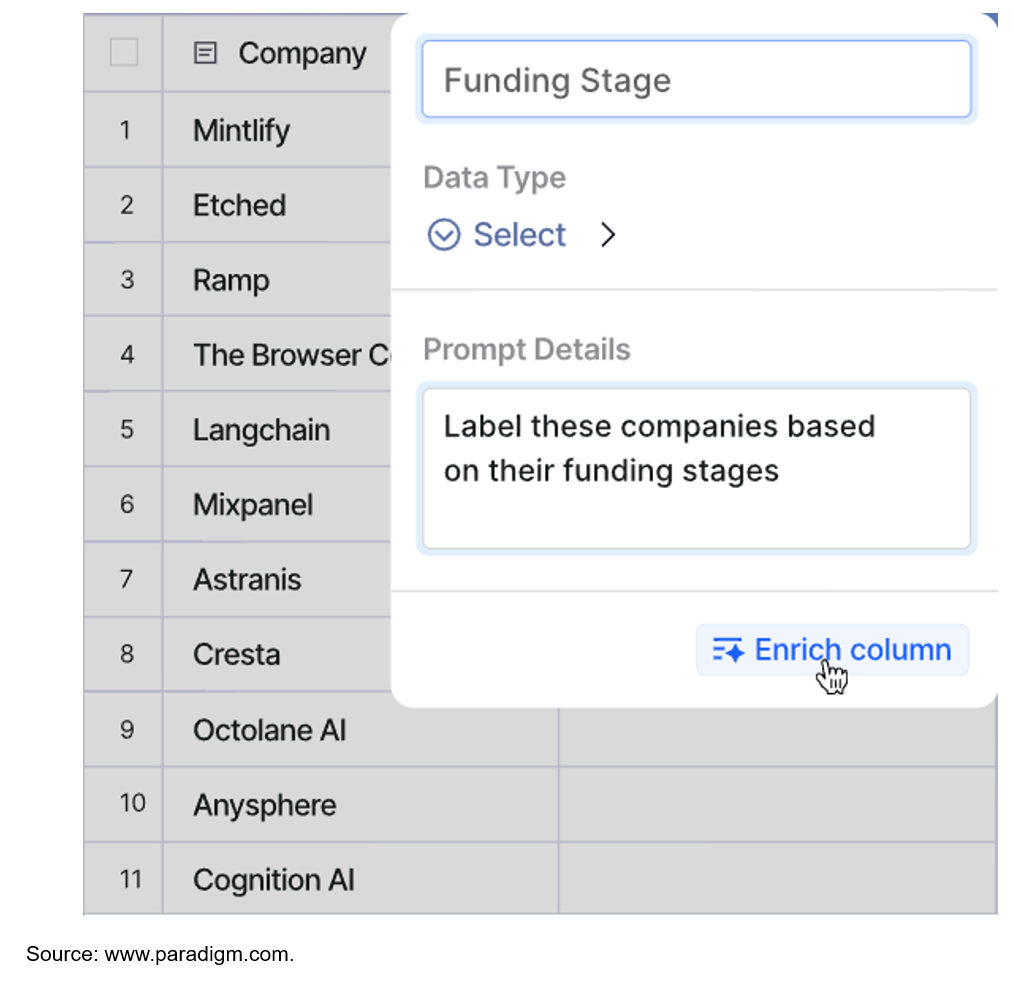
Paradigm leverages natural language processing, machine learning, and automation, using conversational prompts, automating complex calculations, and generating insights without the need for manual formula construction. This is where Excel’s COPILOT function and sibling Copilot feature appear to be heading, too.
In summary, Paradigm’s key features include:
- Natural language queries: Plain English instead of complex formula construction (Copilot will offer this as well).
- Automated data cleaning: I have not managed to test this, but, apparently, Paradigm employs AI-driven routines to identify and resolve inconsistencies or errors in datasets. I am not sure I would trust any AI to clean my data without parallel testing elsewhere.
- Insight generation: It will suggest trends, anomalies, and actionable insights based upon real-time data analysis (Quick Analysis and Analyze Data are two features in Excel that offer similar options).
- Collaboration: Integrated sharing and commenting allow colleagues to work together on the platform (this can be achieved with Excel online, too).
- Cloud integration: Paradigm AI supports real-time cloud synchronization, ensuring data accessibility and version control. How secure and private the information is remains to be seen, but most AI tools are conscious of end users’ concerns here.
The Wall Street Journal and TechCrunch articles commented on Paradigm AI’s ability to simplify complex productivity workflows and empower nontechnical users to derive value from data without extensive training. Its AI-first philosophy is seen as a catalyst for efficiency/productivity gains and automated insights. With free trials and tiered pricing, there is certainly the opportunity to try it out.
So how does it compare to the resident incumbent? Excel remains the benchmark for spreadsheet functionality, cornering the market, forever trying to improve itself.
Paradigm vs. Excel
In Excel, Copilot pops up in shortcut menus and panes, with the COPILOT function allowing prompts to be entered directly into cells. Paradigm AI introduces a conversational interface instead, comparable to the pane in Excel, to achieve similar results. It still may take Excel users time to familiarize themselves with all the features, even though it is user-friendly.
Paradigm’s built-in AI capabilities provide automated insights and data cleaning. Presently, Excel still requires users to leverage separate tools (such as Power Query or Python in Excel) to achieve analogous output.
Both products offer cloud-based collaboration, but Paradigm AI’s integration of commenting and workflow automation is arguably better integrated into its grid. It can be argued it is reliant on cloud infrastructure, which may be a concern for data privacy.
Excel can contest, though, that its many years of rigorous testing, large user base, and extensive customization through VBA, Office scripts, and a wealth of third-party add-ins provide greater flexibility and familiarity that Paradigm AI may not be able to fully challenge at this stage.
Paradigm certainly has real-world applications: quick cleanup and data analysis of voluminous databases, collaborative reporting or implementation of an automated and scalable accounts payable system, whereby it can flag duplicate or suspicious invoices, improving both accuracy and compliance.
Other challenger AI tools
I have focused on one, but other tools are out there. As a nonexhaustive list, other contenders include:
Numerous.ai: Useful for AI-driven formula generation, data cleansing/error corrections, collaborative automated reporting, and dashboard creation. It represents a cost-effective solution for using ChatGPT inside Excel (and Google Sheets).
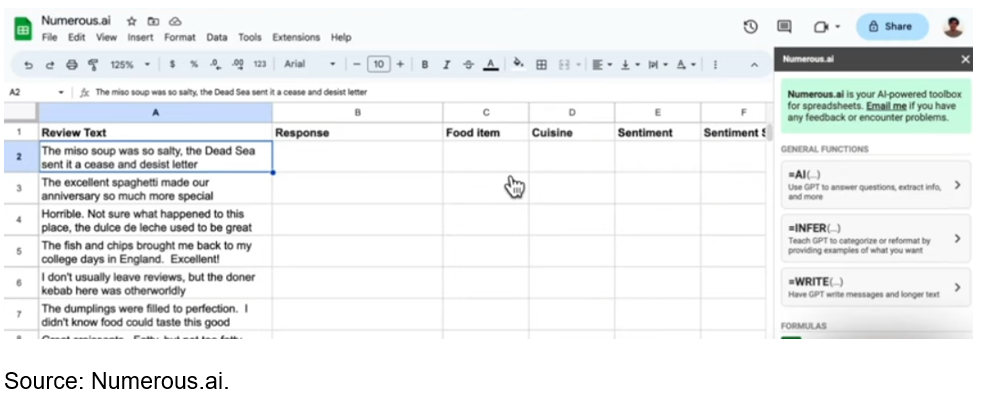
It is intended to streamline complex calculations (using natural language), thus reducing the human error element from the process. Some have commented that its functionality is limited compared to more advanced Excel features, and there is a dependency upon internet connectivity and all the issues that brings into play.
Tryshortcut.ai: Shortcut AI’s website looks eerily similar to a blank Excel workbook:
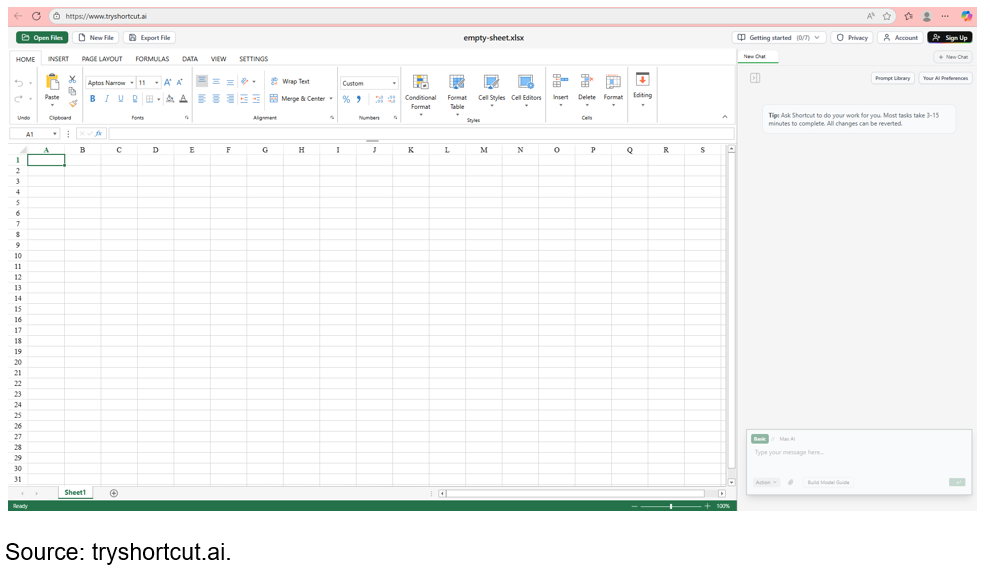
Its main difference is a sidebar chatbot, which is agentic,i.e., it can autonomously perform tasks on your behalf such as searching the internet, consulting additional (re)sources, analyzing/comparing the results, and so on — without explicit prompting.
Indeed, a demo cited in a Mashable article revealed how Shortcut AI took data from a Microsoft discounted-cash-flow analysis and replaced it with Google’s data by using the software giant’s SEC filings and repopulating the assumptions. That is cool.
Shortcut AI can automate workflows and integrate with external applications such as email and CRMs, among other skills. It is highly customizable and allows you to set up complex automations simply (but this is the intention of Power Automate, too).
Again, it may lack advanced analytics compared to some other AI tools, and some users have commented that automations can be complex to configure initially.
Quadratic: This is often cited as one of the better choices for collaboration and technical customization, especially where version control and automation scripting are important. It is seen as a modern spreadsheet that integrates AI connecting directly to your data. It supports formulas, but it also utilizes SQL, Python, and JavaScript.
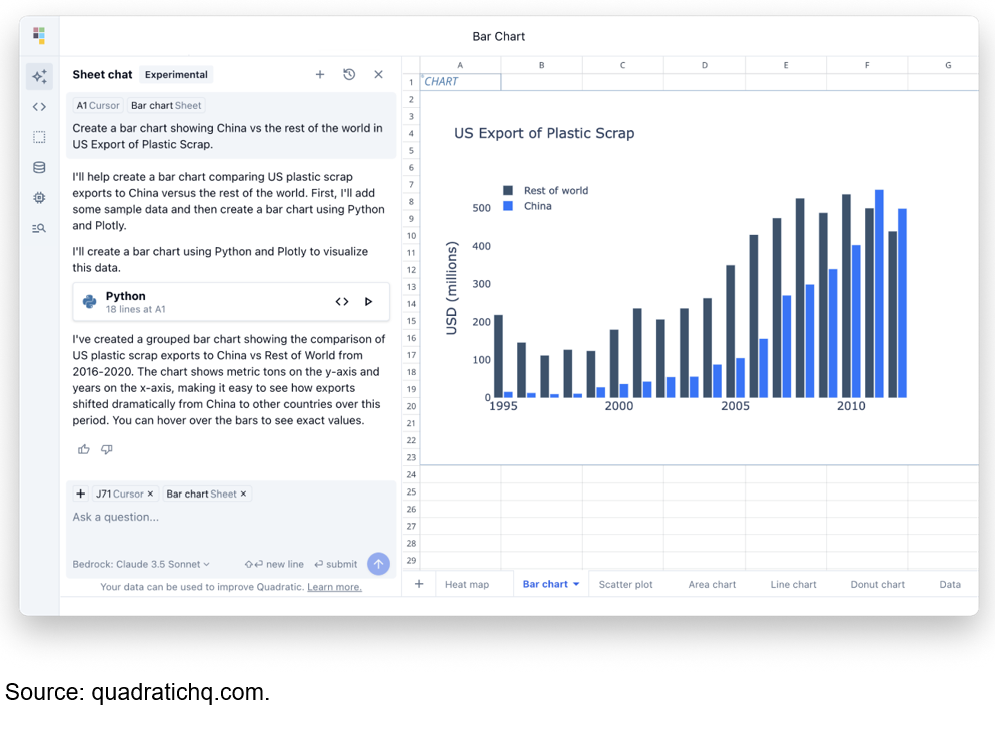
Quadratic is useful for collaborative spreadsheet editing in real time (purportedly better than Excel online), version control, data visualizations, and integrating with coding scripts.
Its advanced features may prove a little intimidating to more casual users, and it can prove problematic to integrate with existing enterprise ecosystems, with potential challenges (none insurmountable) in maintaining security and privacy. But it can be argued these are usual “black box” problems.
And don’t forget other tools:
- Alteryx offers end-to-end data analytics and automation capabilities.
- Tableau (with AI enhancements) can provide predictive analytics, automated insights, and natural language querying.
- Google Sheets (with AI) has smart fill, editable AI-generated visualizations, and formula predictions.
- Workiva focuses on compliance, automation, and collaborative reporting.
- Power BI is Microsoft’s own “self-service BI” tool and is still seen by Gartner as the market leader in the world of business intelligence and is deeply integrated with machine learning/AI. This stand-alone product offers advanced data modeling and better visualizations than Excel.
The following is a suggested — and subjective — summary of the main tools mentioned above:
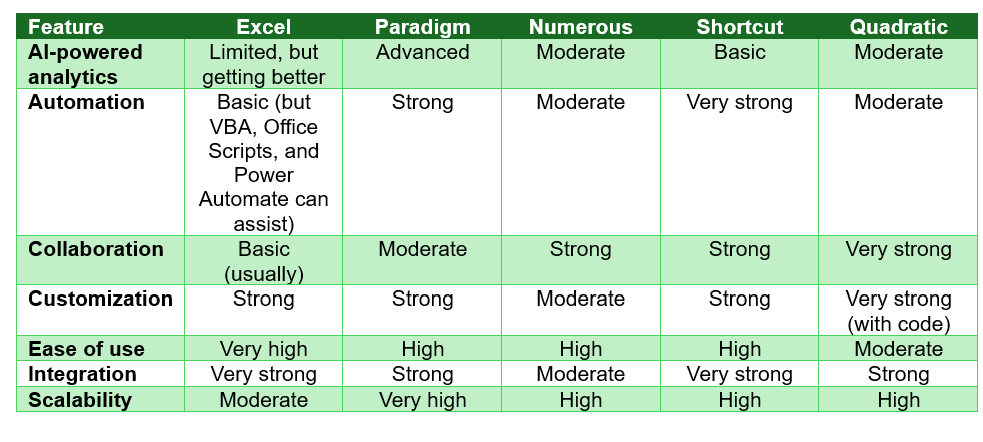
Early adoption?
With all these types of products, yes, you can be left behind by not adopting early, but there is a reluctance to changing if Excel is seen to be keeping up with the times — “if it ain’t broke, don’t fix it.” It depends upon what you seek: Excel has been the victim of many high-profile headlines, detailing coding errors in the spreadsheets, fraud, and security breaches. AI-driven platforms may provide an attractive alternative for tasks such as:
- Processing and analyzing large complex datasets collaboratively.
- Scalability (Excel may need to defer to SQL, R, Python, and others for larger datasets).
- Automating repetitive and manual tasks (beyond Power Query).
- Generating predictive and prescriptive analytics.
- Ensuring data security, compliance, and auditability.
Word to the wise
Excel is so well established it will take a great tool to knock it off its analytical pedestal. Its legacy, popularity, ease of use, and versatility ensure it will remain a vital tool in finance for the foreseeable future. Arguably, that might not be that long in the brave, new AI world.
Its limitations in security, scalability, automation, and advanced analytics are increasingly exposed by upstart, AI-driven competitors such as Paradigm et al. These are paving the way for smarter, more efficient, and automated data management tools — but remember, Excel may become one of these.
As accountants, the danger is to remain loyal to Excel for too long. We need to be vigilant of the disrupters and see Excel more as part of a broader toolkit, augmented and integrated with AI solutions to enhance productivity, accuracy, and strategic decision-making. Successful accountants will be those who will leverage the best of all worlds.
Which tool ultimately wins may become a fragmented contest. Certainly, your data analysis software of choice should align with your business’s needs, technical maturity, and strategic goals. However, like Power BI a decade ago, the new solutions will be subject to major radical changes for years to come. It will be our choice to use the right tools at the right time.
— Liam Bastick, FCMA, CGMA, FCA, is director of SumProduct, a global consultancy specializing in Excel training. He is also an Excel MVP (as appointed by Microsoft) and author of Introduction to Financial Modelling and Continuing Financial Modelling. Send ideas for future Excel-related articles to him at liam.bastick@sumproduct.com. To comment on this article or to suggest an idea for another article, contact Jeff Drew at Jeff.Drew@aicpa-cima.com.
LEARNING RESOURCES
AI-Powered Excel: Leveraging AI and ChatGPT for Supercharged Productivity
This session will have you streamlining your Excel work, research, and documentation, saving you time and effort in your day-to-day tasks.
WEBCAST
Core Concepts of Artificial Intelligence for Accounting Professionals
Unlock the power of artificial intelligence with our comprehensive AI Core Concepts course. Gain a solid foundation in AI components.
CPE SELF-STUDY
MEMBER RESOURCES
Articles
“5 Ways AI Augments the Accountant’s Role,” FM magazine, Sept. 9, 2025
“Financial Modelling With AI: Part 3,” FM magazine, June 11, 2025
“Financial Modelling With AI: Part 2,” FM magazine, June 2, 2025
“Financial Modelling With AI: Part 1,” FM magazine, May 23, 2025



















